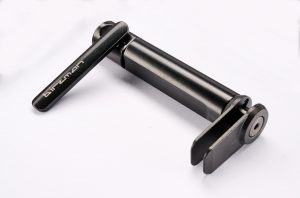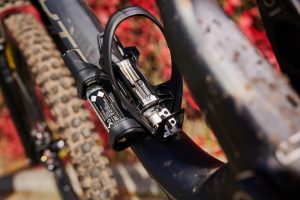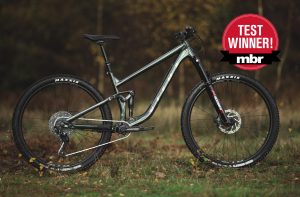The Trek Fuel EXe is a mid-powered electric mountain bike that ticks a whole load of boxes, not least weight, geometry and handling
Trek Fuel EXe first ride review
Say hello to the brand new Trek Fuel EXe, a mid-powered electric mountain bike with some very interesting features, not least the TQ motor which is compact and quiet. With 29er wheels, 150mm front suspension and 140mm rear, could this be the bike that convinces analogue riders to switch it up?
Trek Fuel EXe need to know:
- Brand new Trek Fuel EXe is a 19.28kg (42.51lb) mid-power ebike
- Germany made TQ motor is compact, quiet and delivers 50Nm torque
- All models are powered by the same 360Wh removable battery
- Frame travel gets bumped up to 140mm, combined with 150mm forks
- Available in six models, starting with the Fuel EXe 9.5 at £5,750
- AirWiz comes on both 9.9 models

Trek Fuel EXe
The ebike market has rapidly become a numbers game. Where more torque, increased battery capacity and higher prices are all taken at face value as progress. Well, maybe not the sky high pricing. And while the pedal assist feature guarantees that these high-power machines are very much bicycles, there’s no denying that the metrics on which they are commonly judged are analogous to motorsports.
But much in the same way that cars which handle well, often in spite of their numbers, are referred to as drivers’ cars, the emerging lightweight mid-powered ebike designs have their sights firmly fixed on becoming riders’ bikes.
And on that front, Specialized leads the way with its lightweight Levo SL and Kenevo SL platforms. Compact motors with 35Nm torque and smaller 320Wh batteries offer some assistance, while the reduced weight makes the handling more in keeping with a conventional mountain bike. The main benefit of Specialized’s design being the low-level of resistance in the motor when pedalling above the 15.5mph assistance limit.

The motor and battery are compact enough that the Fuel EXe doesn’t look conspicuously like an eMTB
The Orbea Rise is another ebike outlier, its detuned Shimano EP8 RS motor restricted to 60Nm torque and powered by a 360Wh battery. And while the Rise is a light bike, it could be lighter still with a dedicated motor. But that’s not what makes the Rise interesting. It’s the mid-power level combined with the lightweight that gives it a best of both worlds approach. And it’s an approach we’re going to see a lot more of.
The new Trek Fuel EXe eMTB
Enter the new Trek Fuel EXe. To my knowledge it’s the first truly dedicated lightweight, mid-power ebike from a mainstream manufacturer.
The compact TQ motor delivers 50Nm torque and neatly housed inside the slender down tube is a 360Wh battery (1,835g). The motor weighs 1,850g and because the concentric design is so small it’s hard to distinguish the new Fuel EXe from the non-motorised version. The fact that the TQ motor is almost silent, makes it even harder to tell it apart from the analog Fuel EX.
There are differences though. The EXe has 140mm of travel on the rear married to a 150mm fork, so 10mm more suspension muscle at both ends than the current Fuel EX. It also has more progressive geometry and sizing, a direct result of it being a newer design. The EXe retains some of Trek’s signature features though, like the ABP suspension layout and Mino Link that offers two geometry settings.

The geometry can be adjusted between high and low settings
Total weight for the top-end Fuel EXe 9.8 is 19.28kg (42.51lb). So it’s really a mid-weight, mid-power ebike, given that the Canyon Spectral:On CFR that launched a couple of months ago weighs 22.75kg with a massive 900Wh battery and full-power Shimano EP8 motor.
That said, a 3.47kg weight saving is not to be sniffed at. And if you’re a lighter rider, you’ll definitely feel like less of a passenger on Fuel EXe. Also if weight saving is your primary focus, the EXe 9.9 XTR at £11,500 is almost 1kg lighter than the XX1 AXS build as it doesn’t have any of the additional electronics like the AXS wireless dropper and drivetrain.
Actually, the SRAM XX1 AXS rear derailleur on 9.9 isn’t totally wireless, as it’s wired directly to the main battery. And because it has such a low power drain it will keep shifting long after the 360Wh battery in the downtube refuses to power the TQ motor. So you’ll still be able to limp home under your own steam.

Pedalling the Fuel EXe with the motor off is much easier than on a full power ebike, but it’s still not something I relish. Trek claims that the additional resistance in the motor is only 2 Watts. Maybe I’m just very sensitive, or very lazy, but it feels like there’s more drag than that to me.
Thankfully there’s also a 160Wh (40%) range extender for long days in the saddle. It slots into the bottle cage and connects directly to the changing port that’s located just above it. Not only does this allow for a really short connecting cable, the higher position of the charging port helps keep it clean and dry. The main battery is secured in place with two hex bolts and is easily removed for changing off the bike, or quickly swapped for a second battery.
How the Trek Fuel EXe rides

There’s very little overrun on the TQ motor, but because the pickup is almost instantaneous, it’s not an issue in the same way that it is on, say, the Shimano system. It definitely favours a higher cadence though, so in that respect it still feels very much like an analog bike when you set off in too high a gear. Well, at least until you start to climb.
On shallow gradients the Fuel EXe has the power to sit right at the 15.5mph/25kph pedal assist limit. There’s also really smooth power delivery when you transition from seated to standing when climbing, which really helps maintain traction.

The onboard display can be tweaked using the Trek Central App
There are three power modes, which I’ll call eco, trail and boost as Trek neglected to name them. In eco the motor supplies around 100W of additional power, trail hovers around 180W, while boost will comfortably kick out almost 300W, providing you’ve got the legs to keep going. The OLED screen embedded in the toptube is intuitive to use and easy to read. With four display screens you can scroll through all of the regular metrics, which are fully customisable though the Trek Central app.
It’s not until you get the Fuel EXe onto steeper, technical accents that you really notice the reduced torque. And as the revs decrease and rider effort increases, it’s only then that you notice a soft whirl coming from the TQ motor. In every other situation the Fuel EXe it’s eerily quiet. So quite in fact, that the rattle from the BITS tool stashed inside the steer tube of the new RockShox Lyrik fork becomes unbearable.
And while I’m not a fan of one-piece carbon bar/stem combs, the Bontrager RSL: unit on the top end Fuel EXe has a profile that perfectly mirrors the back sweep of a regular bar with a 50mm stem. At 820mm wide however, I had to cut it down to 780mm, with the grips fitted, after just one ride. The bar also has a lot of flex engineered into it. And while that may help with the overall ride quality, on occasion, it tends to load up and fire back at you, normally when diving into steeper corners, where you are simultaneously loading up the front end while steering.

The one-piece carbon handlebar and stem with tool storage
Our test bike also came equipped with AirWiz, RockShox’s pressure indicators for your suspension. And much in the same way that TyreWiz uses a flashing light system to indicate an operating pressure range, AirWiz does the same for your suspension. Because forks and shocks don’t lose air anything like as rapidly as tyres I can’t help but feel that AirWiz is a bit of a gimmick.
That said, if AirWiz can read the fork and shock pressures in real time, then there’s nothing stopping RockShox layering on its ShockWiz tech, which would be genuinely useful as it would help simplify suspension set-up.
And it’s not like the EXe is lacking suspension technology. The latest RockShox Lyrik fork sporting the Charger 3 RC2 damper, bleed ports on the back of the lower legs and high-frequency vibration isolating Butter Cups that make it feel like you’re running a softer compound front tyre.

The shock-mounted AirWiz
Out back it gets the new RockShox Super Deluxe Ultimate shock, where the triangle of lines at the base of the shock body indicate that it comes with hydraulic bottom out. Like the fork, the shock has a full complement of damping adjustment, but Trek has been a little too heavy handed with the base tune as I had all of the adjusters wide open and the rebound was still borderline too slow for me, at 80kg. And unlike Danny, I don’t run my rebound damping super fast.
So the Trek Fuel EXe wasn’t quite as playful as I expected. And in that respect it rode more like a very capable enduro bike than an out and out trail bike. It’s incredibly stable, the carbon frame is well damped, solid without feeling overly stiff, and Trek has also nailed the geometry and sizing. Hardly surprising then, that I was able to ride some of my local trails faster than ever before.
- The new mid-powered Trek Fuel EXe: range details and prices
- Best electric mountain bikes
Verdict
Has Trek done enough to convince the hardcore analogue rider that is time to supercharge their ride? Only time will tell, but one thing's for sure, the Trek Fuel EXe took my riding to another level.


















